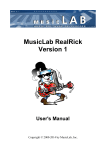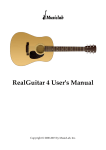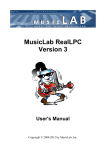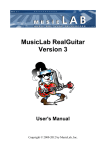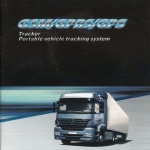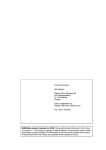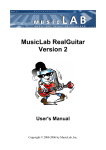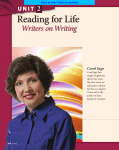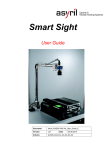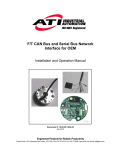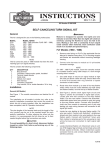Download RealEight User`s Manual
Transcript
RealEight User's Manual
Copyright © 2000-2015 by MusicLab, Inc.
Table of Contents
About the program ................................................................................................. 4
Installing RealEight ................................................................................................. 5
Installing RealEight PC version ......................................................................... 5
Installing RealEight Mac version ....................................................................... 5
Launching RealEight ............................................................................................... 7
Virtual Fretboard ..................................................................................................... 8
Virtual Keyboard ..................................................................................................... 8
RealEight Guitar Patches ........................................................................................ 9
Single ................................................................................................................. 9
Double ................................................................................................................ 9
Quad .................................................................................................................. 9
Bass mode .............................................................................................................. 10
Performance. Keyboard Layout and Controls ................................................... 10
User Keyboard Layout ...................................................................................... 10
Performance Controls ....................................................................................... 11
Velocity Switch Effects ..................................................................................... 11
Permanent Effects ............................................................................................ 12
Pedal Switch Effects ......................................................................................... 13
Modulation Switch Effects ............................................................................... 14
Key Switch Effects ............................................................................................ 14
MIDI Controller pane ...................................................................................... 15
Setup and Sound Controls................................................................................ 16
Left Menu bar .................................................................................................. 16
Output panel .................................................................................................... 16
Tune panel ....................................................................................................... 16
Setup panel ...................................................................................................... 17
Right Menu bar................................................................................................ 18
Timing panel .................................................................................................... 18
Mixer panel ...................................................................................................... 18
FX Mixer panel ................................................................................................ 19
2
Wah-Wah panel................................................................................................ 19
Humanize ........................................................................................................... 21
Sound ............................................................................................................... 21
Timing ............................................................................................................. 22
Velocity ............................................................................................................ 22
Pitch ................................................................................................................. 22
Master section .................................................................................................. 22
Double- and Quad-Tracking ................................................................................ 23
MIDI Guitar Mode ................................................................................................ 24
Importing/Exporting Global Settings ................................................................. 24
RealEight Effect Table and Description .......................................................... 25
MIDI controller additional FXs ........................................................................ 28
Parameter Automation MIDI CC and VST Map ............................................ 30
MIDI CC Automation, value to parameter map ............................................ 32
NRPN map ......................................................................................................... 34
Contacting MusicLab ............................................................................................ 38
3
About the program
RealEight is a sample-based 8-string electric guitar virtual instrument, ideal for lead and
rhythm, and even bass tracks in rock & metal style compositions.
RealEight provides incredible playability based on easy-to-use keyboard layout as well as
the advanced key/pedal/velocity switch system allowing a keyboardist to perform guitar
parts with a whole new level of realistic expression.
RealEight covers practically all sounds, articulations, and techniques a professional
guitarist can produce on his 8-string electric guitar, including mute, bridge mute,
harmonics, pinch harmonics, sliding, scraping, etc...
24-bit high quality dry samples recorded directly from pick-ups let you easily create any
desired guitar sound using your favorite amplifier simulator.
RealEight features:
·
Incredibly deep sound covering huge 5-octave note range (8 strings, 24 frets, drop E
tuning, expandable to drop B tuning).
·
Ready-to-use Double Track and Quad Track patches with a single MIDI input.
·
Bass mode: drops pitch to 8-string bass guitar tuning, letting you produce bass
parts as well.
·
Advanced Humanize section allowing to add realism to the performance both live
and step-recorded in a MIDI track.
·
Multi-channel layering technology, incorporating a custom library of specially
recorded samples taken from every fret of all 8 strings of a real guitar.
·
The unique Floating Fret Position technology, which imitates change of fret position
of a guitarist's hand on the neck. This gives you the possibility of playing on up to
200 guitar frets using just 60 keys of a standard keyboard!
4
Installing RealEight
Installing RealEight PC version
Double-click RealEight Installer file and follow the on-screen instructions.
At the end of installation process RealEight Bank Manager will open and extract sound
bank optimized for particular sample rate which allows using Quick Load mode realized
in RealEight.
In RealEight Bank Manager dialog check the appropriate sample rate box you normally
use in your audio work. Click Apply button to start sound bank extracting. Close Bank
Manager when sound bank installation is completed. Note, that higher sample rate value
will install larger target sound bank.
Important! If Bank Manager window doesn’t open automatically during installation
process you have to run it manually from Start menu/Program Files/MusicLab/RealEight, or
alternatively go to RealEight installation folder (by default: C:\Program
Files\MusicLab\RealEight) and double click StgMan.exe file.
Note that if you want to change sample rate for your audio work you have to run
RealEight Bank Manager and create sound bank optimized for the new sample rate value.
In case your VST2 plugins folder is not registered correctly RealEight installer will not
automatically install RealEight.dll in the correct folder. So to let your VST host ‘find’
RealEight you have to set your VST host to scan MusicLab VST2 folder below.
Please note of RealEight installation folders:
Windows 64-bit
64bit: C:\Program Files\MusicLab\RealEight
32bit: C:\Program Files (x86)\MusicLab\RealEight
64bit VST2: C:\Program Files\Common Files\MusicLab\VST2
64bit VST3: C:\Program Files\Common Files\VST3
32bit VST2: C:\Program Files (x86)\Common Files\MusicLab\VST2
32bit VST3: C:\Program Files (x86)\Common Files\VST3
64bit AAX: C:\Program Files\Common Files\Avid\Audio\Plug-Ins
32bit AAX: C:\Program Files (x86)\Common Files\Avid\Audio\Plug-Ins
Windows 32-bit
32bit: C:\Program Files\MusicLab\RealEight
32bit VST2: C:\Program Files\Common Files\MusicLab\VST2
32bit VST3: C:\Program Files\Common Files\VST3
32bit AAX: C:\Program Files\Common Files\Avid\Audio\Plug-Ins
Installing RealEight Mac version
Double-click RealEight Installer icon and follow the on-screen instructions.
At the end of installation process RealEight Bank Manager will open and extract sound
bank optimized for particular sample rate which allows using Quick Load mode realized
in RealEight.
5
In RealEight Bank Manager dialog check the appropriate sample rate box you normally
use in your audio work. Click Apply button to start sound bank extracting. Close Bank
Manager when sound bank installation is completed. Note, that higher sample rate value
will install larger target sound bank.
Important! If Bank Manager window doesn’t open automatically during installation
process you have to run it manually - open RealEight installation folder (by default:
Macintosh HD/Applications/RealEight) and double click RealEight icon/main
menu/RealEight/Sound Bank Manager.
Note, that if you want to change sample rate for your audio work you have to run
RealEight Bank Manager and create sound bank optimized for the new sample rate value.
Please note of RealEight installation folders:
Application: Macintosh HD/Applications/RealEight
32bit/64bit AU: Macintosh HD/Library/Audio/Plug-ins/Components/RealEight.component
32bit VST2: Macintosh HD/Library/Audio/Plug-ins/VST/RealEight.vst
64bit VST3: Macintosh HD/Library/Audio/Plug-ins/VST3/RealEight.vst3
32bit/64bit AAX: Macintosh HD/Library/Application Support/Avid/Audio/Plugins/RealEight.aaxplugin
6
Launching RealEight
Launching RealEight as a VST/AU/AAX instrument:
1. Open your DAW (host application).
2. Create stereo Software Instrument track.
3. Add RealEight to the track.
4. Open the RealEight window by double-clicking the RealEight button/icon.
5. Launching RealEight multi output version:
One of the most powerful RealEight features is the ability to simulate ‘doubletracked’ or even ‘quad-tracked’ guitar part. To use this feature you must run
RealEight multi output version, RealEight (4 mono) or RealEight (4 stereo),
depending on mono or stereo amps/FXs you are going to use. These plugins
provide 4 outs in your DAW’s mixer. In a DAW’s mixer pan each output being
used, then add the amps/FXs of your choice on each channel.
6. Launching RealEight as a standalone version:
PC: In Start Menu go to Programs/MusicLab/RealEight folder and click on the
RealEight icon.
Mac: Run Applications/RealEight/RealEight.
7
Virtual Fretboard
In RealEight we have realized the Floating Fret Position principle, which imitates change
of fret position of a guitarist's hand on the neck. This gives a unique possibility of playing
on up to 200 guitar frets using just 60 keys of a standard keyboard! This, along with the
fact that we have sampled 24 frets of all eight strings for all of our RealEight sounds,
allows you to emulate a guitar performance with maximum sonic accuracy.
In the center of the RealEight window is the virtual Fretboard, one of the important
elements of the plug-in, which allows you to visualize and control the Floating Fret
Position while playing the guitar part.
The Fretboard has a number of functions:
1. Preview - allows audio previewing the loaded guitar patch by simply clicking on
strings.
2. Display notes - shows the performed notes (with names) in accordance with visual
representation on the fretboard and real sound (you see the notes displayed on
string and fret of exactly the same sound samples currently playing).
3. Fret Position Auto control (the Auto button is pressed) - realizes automatic fret
position change in Solo and Harmony modes, which moves the ‘Capo’ strip along
the Fretboard depending on the sequence of performed notes.
4. Fret Position Manual control (the Auto button is released) - allows manually
changing fret position by right clicking on any fret. A ‘Capo’ strip will appear on
the fretboard, which will prevent playing samples from any fret lower on the neck
than the ‘Capo’ position (except for the 8th string).
Virtual Keyboard
In the lower part of RealEight window you see a virtual keyboard that visualizes
RealEight keyboard layout (Main and Repeat zones), indicates activated Key Switches,
and shows all MIDI notes incoming to RealEight or played on virtual fretboard with a
mouse:
Additionally, virtual keyboard duplicates the external MIDI keyboard input, so everything
you can play by MIDI can be produced on virtual keyboard with a mouse. Shift-clicking
will hold down the pressed key allowing to preview Key Switch FXs.
8
RealEight Guitar Patches
RealEight installs three versions of RealEight soft instrument: RealEight, RealEight (4
mono), RealEight (4 stereo). RealEight is normal plugin with single stereo output,
RealEight (4 mono) provides 4 mono outputs in your DAW, while RealEight (4 stereo)
provides 4 stereo outputs respectively. Choosing between them depends on what guitar
patch you are going to use.
RealEight has three guitar patches loadable by clicking on the appropriate button: Single,
Double, and Quad.
Single
On launching RealEight will automatically load Single guitar patch, which is mono guitar
sample set and can be used in any version of RealEight plugin.
Double
Double, when loaded in RealEight single output version, is a stereo guitar patch panned
hard left and hard right.
When used in multi output versions Double patch gives you the ability to easily simulate
double-tracked guitar parts. To use this feature you must run RealEight (4 mono) or
RealEight (4 stereo) version – these plugins provide 4 outs in your host’s mixer. Double
patch will use first two of them. In host’s mixer, pan each output being used hard left and
hard right, then add the amps + FX of your choice. For best results, we recommend
different amps/settings for each output. Play or sequence notes on the MIDI track
assigned to RealEight, and enjoy a wide, double-tracked sound!
Quad
Quad patch can only be used in RealEight multi out version. Quad patch gives you readyto-use quad-track output with single MIDI In (keyboard or track), allowing you to easily
create quad-tracked guitar parts. For quad-tracking, the process is the same as for doubletracking, but with FOUR audio outputs. You can try panning these outputs differently in
your host mixer, too (e.g.: 100%Left - 80%Left - 80%Right – 100%Right).
The loaded patch name will be displayed on the central Info screen.
9
Bass mode
We’ve implemented special Bass mode allowing to use RealEight for bass parts as well.
Pressing Bass button will drop pitch to 8-string bass guitar tuning: F#-B-E-A-D-G-C-F.
Notes played by MIDI will now trigger lower by octave sounds, thus keeping the whole
keyboard layout unchanged and letting you use the same key switch presets in both
modes.
Performance. Keyboard Layout and Controls
User Keyboard Layout
When connected to RealEight MIDI input the external keyboard is divided into 3 zones:
Main zone (E0 – E5), left (C-1 - D#0) and right (F5 – A6) Repeat zones.
Muted sound
Full sound
Muted sound
E5
E0
Full sound
Main zone
Repeat keys
With Drop B tuning selectable in Bass zone left combo box, the left part of Main zone
expands to B-1.
Main zone serves for playing polyphonic melodic parts, while any key of the Repeat zone
repeats notes and chords played in the Main zone. This way of keyboard mapping allows
you to play guitar parts with 2 hands - you play various notes or chords in the Main zone
with one hand and repeat them by pressing keys in Repeat zone with the other hand,
easily emulating guitar up/down stroke technique.
Repeat Key zone functions:
·
You can repeat notes and chords played in the Main zone (any white key repeats
the full sound, while black key repeats the muted sound).
10
·
Also with the keys of Repeat zone you can alternate up/down/muted strokes to
produce strumming and tremolo techniques. Up and down strokes are triggered by
neighboring keys for both white and black keys of the Repeat zones, like C - up
stroke, D - down stroke, C# – muted up stroke, D# - muted down stroke, and so on.
·
Repeat keys, when activated in Key Switch panel, can also be used as Key Switches
to switch on various FXs.
Performance Controls
RealEight provides you with multiple permanent and switchable controls allowing you to
easily add various specific guitar articulations and effects to your performance.
On the upper part of RealEight window (above the fretboard) you see a number of buttons
and slider controls.
Hold (on/off) - actually Smart Sustain option. When Hold button is on, any pressed and
held key in the Main zone can be used for sustaining the following notes.
Auto (on/off) - toggles between Auto and Manual mode of Floating Fret Position. Manual
mode allows changing the fret position by right-clicking on the Fretboard.
Accent High (0-127) - adjusts the velocity threshold between hard and hardest
performance dynamics.
Accent Low (0-127) - adjusts the velocity threshold between soft and hard performance
dynamics.
Alter samples (1-5) - provides 5 positions of randomly alternating samples while
performing repetitive notes (position 1 provides up to 3 different samples, while position 5
provides up
to 10 different samples), which eliminates the unnatural ‘machine-gun’ effect.
Velocity Switch Effects
On the left lower part of RealEight window you see Velocity Switch FX section including
two FX boxes:
11
Using the Velocity Switch FX controls, two FXs can be dynamically engaged depending on
the velocity of the MIDI notes played. For low velocity notes, set the numeric box on the
left side to the threshold at which notes played at a lower velocity will trigger the FX
selected in the lower FX selector. For high velocity notes, set the numeric box on the right
side to the threshold at which notes played at a higher velocity will trigger the FX selected
in the upper FX selector. As notes are played below or above the two thresholds, the two
FX selector boxes will change to a light grey color to indicate they are being engaged. As
with all FX selectors, each of the two Velocity Switch FX selector boxes have a FX Enable
LED button so you can enable one, both or neither.
Permanent Effects
Permanent FX Box - allows selection of Effect in the pull-down menu and activate it by
clicking on FX Enable LED button in the upper left corner.
Slide > Capo - controls the movement of the capo along the fretboard while performing
either a Slide or Hammer-On effect. You can select any of 3 modes in a Slide>Capo combo
box:
·
Fixed - Capo is not affected. All notes will be played to the right of Capo position
moving from string to string (except for the notes on the 6th string which the capo
does not affect).
·
Ignore - Capo is not affected. Slides ignore Capo position; notes will be performed
along the string moving to another string only in case of reaching first or last fret.
·
Move - Capo moves with Slide or H.O. (Hammer-on) notes along the fretboard.
Legato - enables producing notes played legato within semi-tone or whole-tone from each
other without triggering attacks and being in mono mode (next will mute previous). The
effect is as if the notes were played on the same guitar string when only the first note is
picked and the following notes are played by the left hand alone.
H.O. - enables Hammer-On Effect with automatic Pull-Off on key release, affected note
range is specified (in semi-tones) in numeric box.
Bass Zone - splits the Main Zone of keyboard into two parts to allow individual
performance techniques for each part. The Bass Zone button is toggled on and off. There
are two additional combo boxes to set the lower note (E0, or B-1) and the upper note
(ranging from E1 to E4) of the zone. Bass zone notes have a stronger velocity curve and are
NOT affected by:
·
Mute keys - this allows performing mutes and repetitions on the notes played
outside Bass zone without cutting bass notes.
12
·
Velocity Switch FX - this allows applying velocity switches only to notes played
outside Bass zone while playing bass notes without the velocity switch.
Left combo box works independently of Bass zone button and allows to expand the guitar
range to Drop B tuning by selecting B-1 as the lower note for the 8th string.
In Bass mode this selection is disabled.
Pedal Switch Effects
You can trigger various RealEight Effects selected in Pedal Switch FX box by pressing
normal Sustain Pedal controller.
Pedal Switch FX box has five different controls:
·
1-2 Mono LED (On/Off)
·
FX Enable LED (On/Off)
·
FX Selection pull-down menu
·
Toggle LED (On/Off)
·
Sustain LED (On/Off)
1-2 Mono:
On - sustains all notes except for the notes played at a semi-tone or whole-tone interval
(step-wise melodic run): the next note 1-2 steps apart mutes the previous one as if played
on the same guitar string, while the thirds and larger intervals are being sustained.
Off - pedal sustains all notes played non-legato, and legato (in the case Hammer-On and
Legato FXs are off).
FX Enable LED indicates if the Pedal FX is enabled or not. When LED is On, the FX is
enabled when the Sustain Pedal is pressed.
FX Selection pull-down menu selects which FX is controlled by the Sustain Pedal.
Toggle:
On - indicates that the FX is toggled on and off each time the Sustain Pedal is pressed.
Off - indicates that the FX is only enabled when the Sustain Pedal is kept pressed. When
the Sustain Pedal is not pressed, the FX is not enabled.
13
Sustain:
On - indicates that the Sustain Pedal both turns on the FX as well as sustains notes.
Off - indicates that the Sustain Pedal controls only the FX, and no notes are sustained.
Modulation Switch Effects
You can switch on various RealEight Effects selected in Modulation Switch FX box by
simply moving normal Modulation Wheel of your MIDI keyboard. Releasing Modulation
Wheel to ‘0’ position turns the Effect off.
Note, when Modulation FX box is activated effect assigned in M.W. box at the right will
not work.
Key Switch Effects
RealEight numerous guitar Effects can be triggered using the advanced Key Switch system
allowing to assign various FXs on Repeat Zone keys as well as easily create and use
custom presets in RealEight Key Switch panel.
To open Key Switch panel click on Key Switches button on the left lower part RealEight
window:
Key Switch panel
You see two columns of FX boxes corresponding to Left and Right Repeat Zone keys (C-1
through D#0 for the Left zone, F5 through A6 for the Right zone).
14
Select Effect for a key in pull-down menu and click FX Enable LED button in the left part
of FX box to activate it. Now pressing the correspondent key of Repeat zone will turn on
selected FX, and change the box color to a light grey to indicate that FX is turned on.
Note, that activating FX Enable LED of any key switch will also be displayed on the
RealEight virtual keyboard. Moreover triggering FX will also change color of a virtual
keyboard key to a light blue, giving you full visual control.
Three small buttons (clickable on/off) at the left of each FX box allow additional control of
the Key Switch and FX:
‘T’ button (‘toggle’):
On - indicates that the FX is toggled on and off each time the key switch is pressed
(releasing the key is ignored).
Off - indicates that the FX is only enabled while the key is kept pressed (releasing the key
turns the FX off).
‘K’ button (‘key through’) - when activated allows to switch FX and let the key switch
simultaneously function as normal Repeat key (white for Full sound, black for Muted
sound).
‘S’ button (‘sustain’) adds sustain function to FX, similar using the Sustain Pedal.
Note, Right Key Switches (Right Repeat zone) are ‘toggles’ by default, while Left Key
Switches (Left Repeat zone) are not.
You can save all setting made in Key Switch panel as user presets for future use.
To create a preset, click on Preset combo box to activate Edit mode, type in the preset
name, and press Enter on computer keyboard. Preset will be saved within RealEight and
added to preset list.
To delete preset simply click on Delete icon at the right.
MIDI Controller pane
Velo curve - select the output velocity curve for your performance by pressing one of 4
buttons.
You can assign various guitar effects to standard MIDI controllers:
15
·
P.B. Up (Pitch Bender, upper combo box) - Off, Pitch, Slide, VeloAdd, MonoBend,
Sustainer (triggers Sustainer FX simultaneously with pitch shifting).
·
P.B. Down (Pitch Bender, lower combo box) - ‘same as Up’, Pitch, Slide, VeloAdd,
MonoBend, Sustainer (triggers Sustainer FX simultaneously with pitch shifting).
·
M.W. (Modulation Wheel) - Pitch, Slide, Modulation.
·
A.T. (After Touch) - Pitch, Modulation, Sustainer, FeedBacker.
In the combo box to the right adjust the maximum range of pitch shifting/sliding (in semitones). Modulation envelope is adjusted in Tune panel (Left Menu bar in the upper left
corner of RealEight window).
Setup and Sound Controls
Left Menu bar
In the Left Menu bar you can get access to 3 panels to make global settings: Output panel,
Tune panel, and Setup panel.
Output panel
Volume (+10/-30db) - adjust output volume.
EQ - adjust internal equalizer parameters:
· High (+/- 10db).
· Low (+/- 10db).
Tune panel
Pitch - adjust the master pitch:
·
Coarse (+/-12 semitones).
16
·
Fine (+/-100 cents).
Modulation - adjust the modulation envelope affected by Modulation controller (MIDI
CC#1):
·
Depth (0-100%).
·
Freq (0.2 – 8.0 Hz).
·
Sync LED button (on/off) - when activated the modulation rate will be synched
with host’s tempo.
·
Duration combo box - select note duration value in pull-down menu to match
modulation rate you need.
Setup panel
Keyboard range (C-1- C7) – set the range of your keyboard.
Input device – select between Keyboard and Guitar MIDI input mode:
Keyboard – normal Omni-Channel MIDI input
Guitar – multi-channel MIDI Input, channels 1-8 are mapped to guitar strings 1-8
Octave – shift MIDI Input notes by octaves (up or down) in case your keyboard controller
doesn't have transpose option.
P.B. and M.W. on pressed keys – when activated allows to polyphonically use Pitch Bend,
Modulation Wheel, and Aftertouch controllers with Sustain Pedal, i.e. the controllers will
affect only on actually pressed note(s), while other note(s) being sustained with a Pedal
but physically released will stay untouched. When turned off all controllers work
normally.
Q.Load – pressing Quick Load button allows to quickly load samples and drastically save RAM.
Reset – resets all modified parameters in all modes to their factory values.
Output mode – select between Audio, MIDI, Both options.
Using MIDI Out functionality, the actual MIDI output, including arpeggios, patterns, and
strums generated by notes you play in the "Repeat Zones", can be played back through
any other synth or sampler. Most (but not all) DAWs that support MIDI input from a
virtual synth support recording its MIDI output as well.
Here are a few reasons you might want to take advantage of MIDI Output functionality:
1. To double the RealEight sound with another synth/sampler
2. To replace your guitar part with another sound altogether
3. To generate a MIDI file that's readable by your notation program
17
The "Audio/MIDI/Both" options are important, and as follows:
·
Audio: You'll hear the RealEight samples only, just as you would if you weren't
sending MIDI Out to your synth.
·
MIDI: You'll hear only the synth being driven by the MIDI output from RealEight.
The RealEight samples will not sound.
·
Both: You'll hear both the RealEight samples and the synth being driven by the
MIDI output from RealEight.
Select "MIDI" or "Both" to take advantage of MIDI Out functionality.
Right Menu bar
In the Right Menu bar you can get access to Timing panel, 2 Mixer panels, and Wah-Wah
Effect setting:
Timing panel
Strum time (20-200ms) - adjusts delay for more than one note played simultaneously in
Main zone, as well as the strum time between chord notes played as Interval FX.
Attack time (0-100%) - allows shortening/lengthening the attack of a sound. The shortest
(0%) gives smaller latency, but sounds less natural.
Release time (50-200%) - adjusts how long the note sounds after releasing the key (MIDI
note end).
Multi-Trk Delay (0-400%) - controls proportional delay between tracks in Double and
Quad patches for wider panning.
Mixer panel
2 Mixer sections allow adjusting the volume of various noise effects and additional sounds
that form the modeled guitar sound.
18
Noises:
·
Fret - volume and on/off of a fret noise.
·
Release - volume and on/off of a release noise.
·
Pick - volume and on/off of additional pick noise.
Sounds:
·
Mute - volume of muted sound triggered by Repeat zone keys and used as FX.
·
Switch FX - volume of all additional sounds (Key/Pedal switch FXs).
FX Mixer panel
FX Mixer panel lets you adjust volume for all FX sounds/noises individually.
Wah-Wah panel
Wah-Wah panel allows switching on Wah-Wah Effect, as well as selecting any of 4 WahWah modes available in RealEight and adjust parameters for each mode.
Press FX Enable LED in the upper left corner to switch on the Wah-Wah Effect.
Select Wah-Wah mode in a combo box:
MIDI CC - Wah frequency center is controlled by MIDI CC (set the needed CC# in
numeric box), adjust Filter quality (Qual), lowest frequency (Freq), highest frequency (Freq
(max)).
19
Auto Positive - Automatic Wah effect with positive filter envelope, adjust effect Depth,
Frequency and filter Quality.
Auto Negative - Automatic Wah effect with negative filter envelope, adjust effect Depth,
Frequency and filter Quality.
Modulation - you can adjust filter Quality (dB), lower Frequency (Hz), modulation Depth
(%), modulation Phase (°), modulation Rate (Hz, as well as sync the rate to host’s tempo
and select note duration in pull-down menu), select Trigger mode with on/off clickable
LED.
20
Humanize
You can easily add more realism to the performance (both live played or step-recorded)
using RealEight advanced Humanize option.
Humanize panel
Click on Humanize button in the lower right corner of RealEight window to open the
Humanize panel. Activate the option by clicking on LED in the upper left corner (the LED
is duplicated at the left of Humanize button, so you can switch it on/off even when
Humanize panel is closed).
Humanize Panel has 10 parameters grouped under functional headings: Sound, Timing,
Velocity, and Pitch. Each parameter has individual switch LED and two sliders. The upper
slider controls the maximum range of parameter being applied (steps, milliseconds,
velocity, cents), while the lower one controls the sensitivity of randomization in
percentage (at 100% all playing notes will be affected).
Sound
Pick Position - randomly changes Pick Position parameter value.
· Set maximum range with the ‘steps’ slider.
Resonance - randomly triggers open string adjacent to the current played (works for 5
upper strings). This simulates the effect of a guitarist accidentally striking or resonating
strings.
· Click on Harm or Pinch name to select Harmonics or Pinch Harmonics sound for
resonance.
· Reduce the volume of resonance sound with ‘velo’ slider.
Random Mutes - randomly changes Sustain sound to Mute or Bridge Mute. This simulates
the effect of a guitarist accidentally not pressing the string hard enough.
21
·
·
Click on Mute or Bridge Mute name to select the sound.
Reduce the volume of mute sound with ‘velo’ slider.
Timing
Attack Time - randomly changes the Attack Time parameter value.
·
Set maximum value with 'ms' slider (0-50 msec. range)
Stroke Time - randomly delays the note-on time of all playing notes.
·
Set maximum value with 'ms' slider (0-100 msec. range)
Strum Time - changes the time window between simultaneously played notes (interval,
chord).
·
Set maximum value with 'ms' slider (0-200 msec. range)
Tremolo/Trill - randomizes automatic tremolo or trill notes timing.
· Set maximum value with 'ms' slider (0-100 msec. range)
Velocity
All Strokes - changes velocity values of all playing notes.
Pitch
All Sounds - sharpens the pitch of all sounds.
·
Set maximum value with 'cents' slider (0-50 cents range)
Mute and Bridge Mute - sharpens the pitch of Mute, Bridge Mute sounds.
· Set maximum value with 'cents' slider (0-50 cents range)
Master section
Big LED - switch on or off the Humanize option.
Strength (Master) - add/reduce sensitivity for all parameters proportionally.
Preset - save all setting made in Humanize window as user presets for future use.
To create a preset, click on Preset combo box to activate Edit mode, type in the preset
name, and press Enter on computer keyboard. Preset will be saved within RealEight and
added to preset list.
To delete preset simply click on Delete icon at the right.
Reset - click to reset all settings to factory default values.
22
Double- and Quad-Tracking
‘Double- and Quad-Tracking’ are techniques that are frequently used in recording guitar
tracks. The guitarist plays the same part twice (one for Left channel, and one for Right
channel), and even fourfold (two for Left channel, and two for Right channel). That gives
the guitar track a nice, wide-spread stereo images and a thickness.
You can easily reproduce these techniques by just running RealEight multi output version
(RealEight (4 mono), or RealEight (4 stereo) – these plugins provide 4 outs in your DAW’s
mixer), loading Double or Quad guitar patch, and then panning channels in your DAW’s
mixer and adding amps/FXs on each channel (Double patch will use first two audio
output channels).
With RealEight multi output version you don’t need to create copies of MIDI tracks and
tweak them, but simply use the single track for MIDI data (played or step recorded), and
RealEight sampler engine will process it to true double- or quad-tracked guitar parts with
no identical samples playing simultaneously in different channels!
For wider sound you can add some delay between channels with Multi-Trk Delay slider
found in Right menu bar->Timing panel.
To correctly configure RealEight multi outputs in your DAW, please refer to the DAW’s
User Manual for details.
23
MIDI Guitar Mode
If you prefer to use normal guitar via MIDI interface instead of MIDI keyboard you can
switch to MIDI Guitar mode by selecting Guitar in Setup panel/Input device combo box.
MIDI Guitar mode has multi-channel MIDI input: 1-8 MIDI channels for 1-8 guitar strings
accordingly, with each string/channel having independent pitch bend control, though
Modulation, Aftertouch MIDI controllers, and all other FXs are common for all strings.
MIDI Guitar mode allows you to step record the guitar part with a pencil tool in your
DAW on individual track/MIDI channel for each string. Note, that notes in a track going
out of the appropriate string range will be played on the nearest string.
Importing/Exporting Global Settings
You can save all modifications you’ve made to Global Preset (external *.rgsong file)
containing overall settings, which allows to easily export all changed data as a single file
and import it when needed. Click on RealEight name/MusicLab logo to save/load the
Global Settings:
Note, all current settings are saved within a project doc of your DAW as well.
If you want the current settings load every time you run RealEight, select ‘Save As
Default’ item in the popup menu. To return factory default settings press Reset button in
SetUp panel and select ‘Save As Default’.
24
RealEight Effect Table and Description
Tapping
Mute
Bridge Mute
Harmonics
Pinch Harmonics
Scrapes
Legato (1-2 Steps)
HammerOn (Legato)
Slide (Legato)
Repetition (NoteOff)
Tremolo
Tremolo 1-beat
Trill
Trill 1-shot
Slide Up
SlideUp (trigger)
Slide Down (Fall)
SlideDown (trigger)
Bend
Reverse Bend
Unison Bend
Hold (1-2 Steps Mono)
Interval
Fret Position
PickPosition
String select
Wah-Wah
Violining
Sustainer (trigger)
FeedBacker (trigger)
Chucka FullRange
Chucka MuteKeys
Chucka VeloLayers
FretNoise (trigger)
velo>
velo<
MonoBend (Lower note bend)
VeloAdd (Velocity +/- control)
Effect, Key/Pedal/Mod.Wheel switch
Effect, Key/Pedal/Mod.Wheel/Velocity Switch
Effect, Key/Pedal/Mod.Wheel/Velocity Switch
Effect, Key/Pedal/Mod.Wheel/Velocity Switch
Effect, Key/Pedal/Mod.Wheel/Velocity Switch
Effect, Key/Pedal/Mod.Wheel/Velocity Switch
Effect, Key/Pedal/Mod.Wheel Switch
Effect, Key/Pedal/Mod.Wheel/Velocity Switch
Effect, Key/Pedal/Velocity Switch
Key/Pedal/Velocity Switch
Effect, Key/Pedal/Velocity Switch
Effect, Key/Pedal/Velocity Switch
Effect, Key/Pedal/Velocity Switch
Effect, Key/Pedal/Velocity Switch
Key/Pedal/Mod.Wheel/Velocity Switch, P.Bender
Key Switch
Key/Pedal/Mod.Wheel/Velocity Switch, P.Bender
Key Switch
Key/Pedal/Velocity Switch
Key/Pedal/Velocity Switch
Key/Pedal/Mod.Wheel/Velocity Switch
Effect, Key Switch
Effect, Key/Pedal/ Mod.Wheel/Velocity Switch
Mouse, Key/Pedal Switch
Mouse, Key/Pedal Switch
Key Switch
Effect, Key/Pedal/Mod.Wheel Switch
Effect, Key/Pedal/Mod.Wheel Switch
Key/Pedal Switch, P.Bender
Key/Pedal/Mod.Wheel Switch, P.Bender,AftTouch
Effect, Key/Pedal Switch
Effect, Key/Pedal Switch
Effect, Key/Pedal/Mod.Wheel/Velocity Switch
Key/Pedal Switch
Key/Pedal/Velocity Switch
Key/Pedal/Velocity Switch
P.Bender, Mod.Wheel
P.Bender
Tapping FX reduces initial sound attack and allows to produce legato Hammer-Ons/PullOffs both lower and higher the held note within 24 semitone range. Works in monophonic
mode with initial note and Hammer-Ons/Pull-Offs played on the same string.
Mute FX - left-hand muted sound for notes in the Main zone. Note that the volume of the
Mute FX is controlled by Mixer > Sounds > Mute slider.
25
BridgeMute FX - sound muted near the guitar bridge for notes in the Main zone. It is a
similar effect to Mute FX, however produces different in timbre and more sustained
sound. The tightness of Bridge Mute sound is controlled manually with the slider, or by
velocity value of playing notes in case 1-3 position is selected in the numeric box. With
‘off’ selection velocity of playing notes will not change the length of Bridge Mute sound.
Note, that the volume of the BridgeMute FX is controlled by FxMixer > Bridge Mute slider.
Harmonics FX - chromatic Artificial Harmonic sound for notes in the Main zone. Note that
the volume of the Harmonics FX is controlled by FxMixer > Hrmnx slider.
PinchHarmonics FX - non-chromatic Pinch Harmonic sound for notes in the Main zone.
Note that the volume of the PinchHarmonics FX is controlled by FxMixer > Pinch Hrmnx
slider.
Scrapes FX - 60 different string scrapes, each controlled by the different notes in the Main
zone ranging from E0 to E5. Note that the volume of the Scrapes FX is controlled by
FxMixer > Scrapes slider.
HammerOn (Legato) FX produces Hammer-On/Pull-Off articulation. Hammer-On and
Pull-Off guitar effects enable the playing of grace notes, mordents, trills with a single pick
(and single initial attack). With Hammer-On enabled, press and hold a single key. When a
second key is played, it plays without the initial attack and stops the first note. While
continuing to hold the first key, release the second key and the first note is played again
without the initial attack. When the second key is played higher than the second key, this
is typically called a hammer-on. If the second key is lower than the first key, this is
typically called a pull-off. The Hammer-On effect has a numeric box allowing the user to
select in semi-tones the greatest distance between the first and second note played to be
triggered with the Hammer-On/Pull-Off effect.
Slide (Legato) FX produces sliding articulation between two notes played legato
(glissando with initial attack on the first note only). The Slide FX numeric box controls the
maximum number of semi-tones between two notes that the slide FX will occur. The Slide
FX slider controls the speed of the slide.
Repetition (NoteOff) FX automatically plays additional same note(s) on key(s) release
allowing to produce semi-automatic tremolo with easy dynamics control.
Tremolo FX plays the note(s) repeatedly with the base speed provided by the Tempo
setting (is synched with host’s tempo). Multiples above the Tempo setting are controlled
by the Tremolo FX pull-down menu with choices of 4th, 4T (triplet), 8th, 8T, 16th, 16T,
32nd, 32T, 64th, and 64T note durations. Note that while Tremolo FX is enabled any
secondary notes played are sustained for as long as the first note is played.
Tremolo 1-beat FX works similar Tremolo FX but plays number of notes fitting in one
beat of a measure before sustaining. The speed is controlled by the Tempo setting (is
synched with host’s tempo).
Trill FX plays a continuous trill for as long as the note(s) is held. The Trill FX numeric box
specifies (in semi-tones above the note(s) played) the interval of the trill. The speed of the
trill is controlled by the Tempo setting and the Trill FX pull-down menu with choices of
4th, 4T (triplet), 8th, 8T, 16th, 16T, 32nd, 32T, 64th, and 64T note durations.
Trill 1-shot FX plays a mordent ahead of the note(s) played. The Trill 1-shot FX numeric
box specifies (in semi-tones above the note(s) played) the interval of the mordent. The
speed of the mordent is controlled by the Tempo setting and the Trill 1-shot FX pull-down
26
menu with choices of 4th, 4T (triplet), 8th, 8T, 16th, 16T, 32nd, 32T, 64th, and 64T note
durations.
SlideUp FX articulates automatic slide up TO the note(s) played. The SlideUp FX numeric
box specifies (in semi-tones) the interval to start the slide from. The SlideUp FX slider
controls the speed of the slide.
SlideUp (trigger) FX triggers automatic slide up FROM the sustaining note(s). Velocity of
trigger key affects slide dynamics.
SlideDown FX articulates automatic slide down FROM the note(s) played. The SlideDown
FX numeric box specifies (in semi-tones) the destination interval for the slide. The
SlideDown FX slider controls the speed of the slide.
SlideDown (trigger) FX triggers automatic slide down FROM the sustaining note(s).
Velocity of trigger key affects slide dynamics.
Bend FX articulates automatic bend up TO the note(s) played. The Bend FX numeric box
specifies (in either 1 or 2 semi-tones) the interval to start the bend from. The Bend FX
slider controls the speed of the bend.
ReverseBend FX articulates automatic ‘pre-bend and release’ down to the note(s) played.
The ReverseBend FX numeric box specifies (in either 1 or 2 semi-tones) the interval to start
reverse bend from. The ReverseBend FX slider controls the speed of the bend.
UnisonBend FX articulates two notes played, one being the played on the Main zone, and
the second one starting from one or two semi-tones below is bent up to the note played.
The UnisonBend FX numeric box controls if the second bent note starts from one or two
semi-tones below. The UnisonBend FX slider controls the speed of the bend.
Hold FX provides sustain effect similar to the Sustain Pedal.
Interval FX plays additional note(s) to the one played in the Main zone. Interval FX pulldown menu options are: mono, 4th down, 5th up, Octave up, Power (5th + 4th up),
Power2 (5th + 4th up), 2 Octaves up, Power Oct (two power chords in octave) and Power 2
Oct (two power chords 2 in octave). Note that when Interval FX is enabled, the keyboard is
in monophonic mode and only a single key can be played at a time.
FretPosition FX controls the Capo along the fretboard. The FretPosition FX pull-down
menu option of “F5 … C6” allows the Capo to be controlled by the 8 Right Repeat keys
starting from F5, up to C6 selecting the 17th fret. The FretPosition FX pull-down menu
option of “Open" forces the Capo to remain open. The remaining pull-down menu options
select one of the 20 frets (frets numbers marked with *, or ** correspond to the frets
marked on the RealEight fretboard).
PickPosition FX controls the position of the pick on the strings to provide different sound
(farther or closer to the bridge). The PickPosition numeric box ranges from -7 to +7. The
Pick Position can also be changed via the main RealEight window by clicking and
dragging the pick between the pickups on the high E-string.
String Select Fx allows to manually select the needed string, which lets you play as many
notes on the selected string as possible for the string range.
Wah-Wah FX provides a traditional guitar wah-wah pedal effect. The Wah-Wah FX pulldown menu options for control are: MIDI-Control, Auto Positive, Auto Negative and
27
Modulation. Wah-Wah FX parameters can be modified in the Wah-Wah panel accessible
from Right Menu bar in the upper right corner of the RealEight window.
Violining FX provides a volume swell with a smooth attack. The Violining FX slider
controls the swell time.
Sustainer (trigger) FX triggers a ‘sustainer’ effect for any notes currently being played in
the Main zone. The sound swells with every key press and can sustain as long as you
trigger the effect.
FeedBacker (trigger) FX triggers a harmonic feedback for the note(s) being played in the
Main zone (for the last in time pressed note in case of a chord). The FeedBacker FX pulldown menu provides the following harmonic selections: 8 (octave), 5’ (octave and a fifth),
8’ (two octaves), 5’’ (2 two octaves and a fifth), 8'' (three octaves), and 5’’’ (three octaves
and a fifth).
ChuckaFull FX provides muted chords in 4ths (so called, chucks) played in the Main zone
which emulates ‘chucka-chucka’ guitar technique. Main zone is in mono mode with each
key triggering individual chord/fret. With notes played from E3 and higher, ChuckaFull
FX chords will move higher with each increased semi-tone along the fretboard. Right
Repeat zone keys repeat the chords played in Main zone and can alternate between two
string groups: F#5 triggers lower strings (5-4-3 strings), and G5 and higher trigger upper
strings (3-2-1 strings). Left Repeat keys (D#1 and lower) repeat the last layer produced in
Right Repeat zone.
ChuckaMuteKeys FX provides muted chords in 4ths with Black Repeat (Mute) keys (Main
zone and white keys of Repeat zone continue to work normally). Right Repeat zone Mute
keys can alternate between two string groups: F#5 triggers lower strings (5-4-3 strings),
G#5 and higher trigger upper strings (3-2-1 strings), and Left Mute keys (D#1, C#1, etc..)
repeat the last layer produced in Right Repeat zone.
ChuckaVeloLayers FX provides muted chords in 4ths played in the Main zone similar to
ChuckaFull FX, however can produce 3 velocity controlled string groups by any key of the
whole range. Low velocity strokes trigger 5-4-3 string layer, middle velocity strokes trigger
4-3-2 strings layer, while high velocity strokes trigger 3-2-1 string layer (the higher velocity
value - the higher string group is triggered).
FretNoise (trigger) FX triggers FretNoise sound. Enabling the FX will switch off the
automatic FretNoise generating on note-offs.
Velo > FX activates higher Velocity Switch FX selected in Higher Velocity Switch box.
Velo < FX activates lower Velocity Switch FX selected in Lower Velocity Switch box.
MIDI controller additional FXs
MonoBend FX (Pitch Bender and Modulation Wheel) applies pitch bending: a) only to the
lowest of simultaneously played notes, b) only to the first bent and held note, allowing to
emulate guitar specific single-string bending techniques: Unison Bend, Bend/Release
combined with sustained note(s), etc…
Example 1 - assign MonoBend to P.Bender, press and hold 2-3 notes in Main zone, then
move P.Bender - only the lower note will be bent (if you then move P.Bender back while
holding all played notes only the first note will be affected).
28
Example 2 - assign MonoBend to P.Bender, play a note, move P.Bender to bend the note,
then holding the first note bent play the second note higher or lower the first one - next
note(s) will play their real pitch (if you then move P.Bender back while holding all played
notes, only the first previously bent note will be affected).
VeloAdd FX (Pitch Bender) allows continuous adding/reducing velocity value (+/-) to
the played notes.
Slide FX (Pitch Bender and Modulation Wheel) allows manual articulation of Up/Down
slides from/to played note(s).
29
Parameter Automation MIDI CC and VST Map
RealEight
MIDI CC #
VST name
Output
Volume
EQ, High
EQ, Low
7
29
30
Volume
EQ-High
EQ-Low
Tune
Pitch, Coarse
Pitch, Fine Tune
Modulation, Depth
Modulation, Freq
12
13
14
15
PtchCrse
PtchFine
ModDepth
ModFreq
Mixer
Mixer_Muted_sound, Volume
Mixer_Switch_FX, Volume
Mixer_FretNoise, on/off,
Mixer_FretNoise, Volume
Mixer_ReleaseNoise, on/off
Mixer_ReleaseNoise, Volume
Mixer_Pick/Noise, on/off
Mixer_Pick/Noise, Volume
20
22
23
24
25
26
27
28
MxMuted
MxKeyFx
MxFrtN_
MxFrtNse
MxRelN_
MxRelNse
MxPckN_
MxPckNse
Wah-Wah
Wah-Wah, On/Off
Wah-Wah_mode, select
47
46
WahOnOff
WahMode
Controls
Alter_sample, mode
Accent_High_Threshold
Accent_Low Threshold
Release_Time
Attack_Time
Strum_Time
Pick_Position, select
Fret_Position, select
Auto_Fret_Position, on/off
Hold, on/off
FX_HammerOn, select
FX_HammerOn, Steps
Legato, on/off
BassZone, on/off
BassZone, rangeHigh
52
51
53
55
49
56
50
78
79
64
35
36
18
40
41
AltSmple
VelTrshH
VelTrshL
RlseTime
AtckTime
StrmTime
PickPos
FretPos
AutoFret
Hold
HOFx_
HOSteps
Legato
BassZone
BasRngUp
30
Controllers
Pitch_BenderUp, Mode
Pitch_BenderDown, Mode
PBenderUp_to_Slide, Range
PBenderDown_to_Slide, Range
PBender_to_Pitch, Range
Modulation_Wheel, Mode
ModWheel_to_Slide, Range
ModWheel_to_Pitch, Range
Aftertouch, Mode
Aftertouch_to_Pitch, Range
Velocity_Curve, select
57
48
58
63
59
60
61
62
75
76
77
PBupMode
PBdnMode
PBSldRng
PBdnSlRn
PBPtcRng
WhMode
WhSldRng
WhPtcRng
AtchMode
AtchRng
VelCurve
31
MIDI CC Automation, value to parameter map
CC#12, PtchCrse
0-2
-12
3-7
-11
8-13
-10
14-18
-9
19-23
-8
24-29
-7
30-34
-6
35-39
-5
40-44
-4
45-50
-3
51-55
-2
56-60
-1
61-66
0
67-71
1
72-76
2
77-82
3
83-87
4
88-92
5
93-97
6
98-103
7
104-108
8
109-113
9
114-119
10
120-124
11
125-127
12
CC#48, PBdnMode
0-10
As up
11-31
Off
32-52
Slide
53-74
Pitch
75-95
VeloAdd
96-116
MonoBend
117-127
Sustainer
CC#50, PickPos
0-4
-7
5-13
-6
14-22
-5
23-31
-4
32-40
-3
41-49
-2
50-58
-1
59-68
0
69-77
1
78-86
2
87-95
3
96-104
4
105-113
5
114-122
6
CC#13, PtchFine
64-127
0-(+100c)
64
0
0-64
0-(-100c)
CC#36, HOSteps
0-5
1
6-17
2
18-28
3
29-40
4
41-51
5
52-63
6
64-75
7
76-86
8
87-98
9
99-109
10
110-121
11
122-127
12
CC#46, WahMode
0-22
MidiCC
23-63
Auto(Pos)
64-86
Auto(Neg)
87-127
Modulation
CC#52, AltSmple
0-15
1
16-47
2
48-79
3
80-111
4
112-127
5
CC#57, PBupMode
0-12
Off
13-38
Slide
39-63
Pitch
64-88
VeloAdd
89-114
MonoBend
115-127
Sustainer
CC#58, PBSldRng
0-5
1
6-17
2
18-28
3
29-40
4
41-51
5
52-63
6
64-75
7
76-86
8
87-98
9
99-109
10
110-121
11
122-127
12
CC#41, BassRang
0-1
E1
2-5
F1
6-8
F#1
9-12
G1
13-15
G#1
16-19
A1
20-22
A#1
23-26
B1
27-29
C2
30-33
C#2
34-37
D2
38-40
D#2
41-44
E2
45-47
F2
48-51
F#2
52-54
G2
55-58
G#2
59-61
A2
62-65
A#2
66-68
B2
69-72
C3
73-75
C#3
76-79
D3
80-82
D#3
83-86
E3
87-89
F3
90-93
F#3
94-97
G3
98-100
G#3
101-104
A3
105-107
A#
108-111
B3
112-114
C4
115-118
C#4
119-121
D4
122-125
D#4
126-127
E4
CC#60, WhMode
0-15
Off
16-47
Slide
48-79
Pitch
80111
Modulation
112-127
MonoBend
CC#75, AtchMode
0-15
Off
16-47
Pitch
48-79
Modulation
80-111
Sustainer
32
123-127
7
CC#59, PBPtcRng
0-4
12
5-13
11
14-22
10
23-31
9
32-40
8
41-49
7
50-58
6
59-68
5
69-77
4
78-86
3
87-95
2
96-104
1
105-113
1/2
114-122
1/4
123-127
1/8
CC#63, PBdnSlRn
0-5
1
6-17
2
18-28
3
29-40
4
41-51
5
52-63
6
64-75
7
76-86
8
87-98
9
99-109
10
110-121
11
122-127
12
CC#61, WhSldRng
0-5
1
6-17
2
18-28
3
29-40
4
41-51
5
52-63
6
64-75
7
76-86
8
87-98
9
99-109
10
110-121
11
122-127
12
CC#78, FretPos
0-3
0
4-10
1
11-17
2
18-24
3
25-31
4
32-38
5
39-45
6
46-52
7
53-59
8
60-67
9
68-74
10
75-81
11
82-88
12
89-95
13
96-102
14
103-109
15
110-116
16
117-123
17
124-127
18
112-127
Feedbacker
CC#62, WhPtcRng
0-4
12
5-13
11
14-22
10
23-31
9
32-40
8
41-49
7
50-58
6
59-68
5
69-77
4
78-86
3
87-95
2
96-104
1
105-113
1/2
114-122
1/4
123-127
1/8
CC#77, VelCurve
0-21
1
22-63
2
64-105
3
106-127
4
CC#76, AtchRng
0-15
2
16-47
1
48-79
1/2
80-11
1/4
112-127
1/8
33
NRPN map
Format: (<NRPN MSB>, <NRPN LSB>, <Data Entry MSB>[, <DataEntry LSB>]) <Description>. {<Comment>.}
(0, key, msb, lsb) - Set Pitch Bend for the key to ((msb<<7) | lsb)-8192.
(1, key, fx) - Select FX for the key, sustain pedal or velocity of a stroke.
key - key id, see Key Map below.
fx-5 - fx id, see FX Map below.
(2, key, on) - Switch the key fx.
key - key id, see Key Map below.
on - 0/1 for Off/On.
(3, key, opt) - Set options of the key fx.
key - key id, see Key Map below.
opt - bit field: <toggle> | (<do sustain> << 1) | (<play stroke> << 2)
(4, key, msb, lsb) - Set first parameter of the key fx if any, ignored otherwise.
key - key id, see Key Map below.
((msb<<7) | lsb)-8192 - value of the parameter 1.
For specific parameter ranges and meanings see FX Map below.
(5, key, msb, lsb) - Set second parameter of the key fx if any, ignored otherwise.
key - key id, see Key Map below.
((msb<<7) | lsb)-8192 - value of the parameter 2.
For specific parameter ranges and meanings see FX Map below.
Key Map
Format: <key id> - <Description>. {<Comment>.}
0
- Sustain Pedal. Available fxes -5..34.
1
- Upper velocity zone. Available fxes 0..34.
2
- Lower velocity zone. Available fxes 0..34.
3..18 - C0..D#1 Key switches. Available fxes -2..34.
19..35 - D#5..G6 Key Switches. Available fxes -2..34.
36 - Modulation. Available fxes -2..34.
FX Map
Format: <fx id>, <name> [, <par1 rng>[, <par2 rng>] - <parameters' names>]
-2, velo upper
-1, velo lower
0, Tapping
1, Mute
34
2, BridgeMute,
3, Harmonics
4, PinchHarmonics
5, Slap
6, Scrapes
7, HammerOn(Legato),
8, Slide(Legato),
10, Repeat(NoteOff)
11, ChuckaFull
12, ChuckaMuteKeys
13, Tremolo,
14, Tremolo 1 beat,
15, Trill,
16, Trill 1 shot,
17, SlideUp,
18, SlideUpTrig,
19, SlideDown,
20, SlideDownTrig,
21, Bend,
22, ReverseBend,
23, UnisonBend,
25, Hold
27, Sustainer(trigger)
28, Violining,
29, Interval,
30, FretPosition,
31, PickPosition,
32, Wah-Wah,
33, FeedBack(trigger),
34, ChuckaVeloLayer
35, VeloMute
36, Legato
37, String
39, FretNoise
0..128, 0..3
- ctrl val, velo sensitivity
0..48
- range
0..48, 30..150 - range, time
0..9
- duration id (see Duration Map)
0..9
- duration id (see Duration Map)
1..12, 0..9 - interval, duration id (see Duration Map)
1..12, 0..9 - interval, duration id (see Duration Map)
1..12, 40..500 - range, time (ms)
1..12, 40..500 - range, time (ms)
1..12, 40..500 - range, time (ms)
1..12, 40..500 - range, time (ms)
1..2, 100..800 - interval, time (ms)
1..2, 100..800 - interval, time (ms)
1..2, 100..800 - interval, time (ms)
300..2000
0..8
-1..20
-7..+7
0..3
0..5
- time (ms)
- interval id (see Interval Map)
- fret position id (see Fret Position Map)
- pickup position
- wah-wah mode id (see Wah-Wah Mode Map)
- feedback interval id (see Feedback Interval Map)
1..127
- velocity
0..8
- 0..7 - string 1..8, 8 - auto
- Fret Noise
Duration Map
Format: <duration id>, <description>
0, 4th
1, 4T
2, 8th
3, 8T
4, 16th
5, 16T
6, 32nd
7, 32T
8, 64th
35
9, 64T
Interval Map
Format: <interval id>, <description>
0, mono
1, 4th down
2, 5th up
3, Octave
4, Power
5, Power2
6, 2 Octaves
7, Pwr Oct
8, Pwr 2 Oct
Fret Position Map
Format: <fret position id>, <description>
-1, D#5..C6
0, Open
1, Fret 1
2, Fret 2
3, Fret 3 *
4, Fret 4
5, Fret 5 *
6, Fret 6
7, Fret 7 *
8, Fret 8
9, Fret 9 *
10, Fret 10
11, Fret 11
12, Fret 12 * *
13, Fret 13
14, Fret 14
15, Fret 15 *
16, Fret 16
17, Fret 17 *
18, Fret 18
19, Fret 19 *
20, Fret 20
Wah-Wah Mode Map
Format: <wah-wah mode id>, <description>
0, MIDI Control
36
1, Auto Positive
2, Auto Negative
3, Modulation
Feedback Interval Map
Format: <feedback interval id>, <description>
0, 8
1, 5'
2, 8'
3, 5''
4, 8''
5, 5'''
37
Contacting MusicLab
Web site: http://www.musiclab.com/
Technical support: mailto:[email protected]
38








































